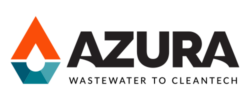Azura’s experience with food waste anaerobic digestion and our work on advanced digester monitoring tools were the basis for one of two podium presentations scheduled for the 2020 WEAO conference.
The Water Environment Association Ontario (WEAO) is the leading association of wastewater professionals in Ontario with over 1,200 members. As a regional chapter of the international Water Environment Federation (WEF), WEAO supports the water and environment industry by providing networking and connections between wastewater experts and young professionals alike, publishing a high-quality technical magazine, and organizing events with expert technical content.
The premier WEAO event is its annual technical symposium and exhibition, where thousands of wastewater professionals gather with other experts to share the latest information in the wastewater field. The 2020 edition of the conference was scheduled for April 2020. Although the COVID-19 pandemic caused the in-person conference to be cancelled, the technical papers were published online. One paper titled “Digester Failure and Recovery—Full-scale experience with an Ontario-based food waste digester and lessons learned in advanced digester monitoring” was authored by Azura’s David Ellis, Professor Wayne Parker of the University of Waterloo, and Dodge Yu.
Adapted from the Abstract:
Anaerobic digestion (AD) of food waste and municipal source separated organics (SSO) to generate renewable energy, reduce solid wastes, manage nitrogen and phosphorous, reduce greenhouse gases and mitigate pollution risks has considerable benefits. In Ontario, the use of AD assets at municipal water resource recovery facilities (WRRFs) to digest organic waste remains an under-developed opportunity. In contrast, in the US, 17% of WRRFs imported organic waste for anaerobic co-digestion (AnCoD) with wastewater solids. A survey of 72 WRRFs reported that fat, oil, and grease (FOG) was the most commonly accepted material. The interest in AnCoD of FOG is due to the high energy content and ease of handling FOG slurry feedstock.
FOG includes short, medium, and long-chain fatty acids (LCFA) as well as other lipids. The degradation of lipids and LCFAs by AD was described in the scientific literature more than 50 years ago, and the inhibitory nature of LCFAs on the AD process was reported more than 30 years ago. The study of LCFA degradation in AD systems remains a topic of ongoing study and concerns regarding toxicity from LCFAs continue to receive attention. However, many of these studies were small-scale and do not represent the complexities of full-scale operations.
In addition to LCFAs, the literature also identifies the risk of inhibition of AnCoD processes due to ammonia-nitrogen (NH3-N). In AnCoD processes, organic nitrogen present in proteinaceous wastes will hydrolyze to form NH3-NH4. Little data on NH3 and LCFAs in full-scale AD operations has been reported when viewing stability of AnCoD facilities. As Ontario municipal sewage digesters consider AnCoD of food wastes to increase the production of biogas, a more fulsome understanding of the potential risks associated with feeding food waste and how to avoid process upsets is required. For digester operators, these issues lead to questions regarding how digester instability is assessed in full-scale operations.
Regular monitoring of AD is required to ensure stable performance of the digestion process and avoid upsets. Experience with full-scale food and agricultural co-digestion facilities has shown that the typical parameters that are employed in practice are insufficient to ensure digester stability. A tool that incorporates biogas methane (CH4) content, pH, VFAs, alkalinity, LCFAs, NH3-NH4 in the calculation of a digester stability score has been proposed by Cook, S.M., Skerlos, S., Raskin, L., Love, N. A Stability Assessment Tool for Anaerobic Codigestion (2017). However, LCFA data from full-scale facilities was not available to validate the proposed tool. There is a need to improve the tool to guide decision making regarding operations (i.e. loading rates and feedstock selection).
This paper reviewed some of the key digester operating and monitoring parameters, including VFAs, LCFAs, and FOG. The paper presents the findings of a full-scale case study where Azura helped a food-waste market digester recover from operational failure.
Using real-world data from the full-scale anaerobic digester failure, the paper calculated the digester stability score using the method proposed by Cook et al. in 2017. That tool did not provide a useful predictor of digester failure, and modifications to the tool were explored
For more information about WEAO and the annual conference, please visit them here: WEAO
Get Insights from the Bioprocess Experts Right to Your inbox
Sign up to the Discover Digesters Newsletter to access Azura’s best practices, field-tested advice, and insights into the anaerobic digestion & industrial wastewater treatment industries.
By submitting this form, you are consenting to receive marketing emails from: Azura Associates. You can revoke your consent to receive emails at any time by using the SafeUnsubscribe® link, found at the bottom of every email. Emails are serviced by Constant Contact.

